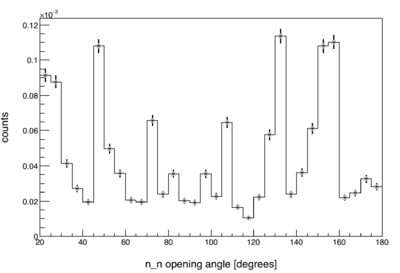Difference between revisions of "2NCorr SPDP Introduction"
Jump to navigation
Jump to search
| Line 1: | Line 1: | ||
[[Production Analysis | go_back ]] | [[Production Analysis | go_back ]] | ||
| − | Our array of detectors has a highly non-uniform neutron efficiency and acceptance w.r.t. neutron-neutron opening angle (<math> | + | Our array of detectors has a highly non-uniform neutron efficiency and acceptance w.r.t. neutron-neutron opening angle (<math>\theta_{n-n}</math>). This is due to the array's non-spherically symmetric geometry, and to its neutron detection efficiency as a function of both particle position and energy (see figure). For this reason, every measured distribution is made meaningful by the normalizing against another distribution. For <math>\theta_{n-n}</math>, |
[[File:2N Corr OpeningAngleCf252.png|thumb| right|400px| Measured opening angle distribution of uncorrelated neutrons from Cf252 target.]] | [[File:2N Corr OpeningAngleCf252.png|thumb| right|400px| Measured opening angle distribution of uncorrelated neutrons from Cf252 target.]] | ||
Revision as of 21:46, 19 January 2018
Our array of detectors has a highly non-uniform neutron efficiency and acceptance w.r.t. neutron-neutron opening angle (). This is due to the array's non-spherically symmetric geometry, and to its neutron detection efficiency as a function of both particle position and energy (see figure). For this reason, every measured distribution is made meaningful by the normalizing against another distribution. For ,
